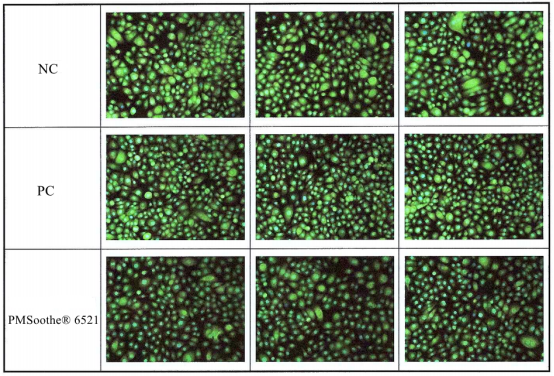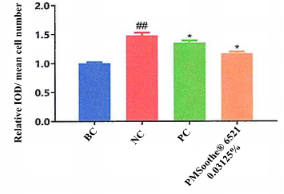Sensitive skin refers to a state of hyperreactivity of the skin that occurs under physiological or pathological conditions, mainly on the face. TRPV1 is an ion channel receptor, also known as capsaicin receptor, which is a multiphase receptor widely distributed in the peripheral nervous system and can be activated directly or indirectly by various ligands such as capsaicin, causing an increase in intracellular Ca2t and triggering action potentials. The higher the expression of TRPVI, the higher the neurosensitivity of the skin, and the inhibition of TRPVI expression can have a certain nnerve soothing effect. When TRPV1 is inhibited by the test substance, TRPV1 expression and intracellular Ca is decreased, which could indicate that the test substance could achieve the soothing effect by inhibiting TRPV1.
Plamed developed a new cosmetics ingredient, PMSoothe® 6521 with excellent skin-soothing effect. This article, we will show you the effect of PMSoothe® 6521 to inhibit the expression of TRPV1.
Based on keratinocytes, Plamed did a test to evaluate the soothing effect of the sample PMSoothe® 6521 to be tested by detecting changes in capsaicin receptor (TRPV1) content
More information, please visit PMSoothe® 6521 Introduction.
TRPV1 Test method
1) Cell seeding: After cell recovery, the cells were inoculated to 24-well plates when the rate of planking reached about 60%, and incubated overnight in an incubator (37°C, 5% CO2).
2) Liquid preparation: Prepared the working liquid of the test substance according to the test program (Table 2).
Table 2. Test program
| Groups | Sample information | Detection Systems | ||||
| Sample name | Concentration | Stimulus | Indicator | Test
model |
Test
method |
|
| Blank control (BC) | / | / | / |
TRPV1 |
Keratinocytes |
IF |
| Negative control (NC) | / | / |
Capsaicin (15μM) |
|||
| Positive control (PC) | trans-4-tert-
butylcyclohexanol |
15.6μg/mL | ||||
| Sample | PMSoothe® 6521 | 0.03125% (m/v) | ||||
- Dosing: According to the test plan in Table 2, when the plating rate of cells in the 24-well plate reaches 40%-60%, each group treated with correspond working solution, and each group had 3 multiple wells. Each well of the blank control group was added with 1mL culture solution; each well of the negative control group was added with 1mL culture solution containing capsaicinand trans-4-tert-butylcyclohexanol; each well of the positive control group was added with 1mL culture solution containing capsaicin and the corresponding concentration of the sample to be test After dosing, place it in the incubator (37°C, 5% CO2) and incubate for 24 hours.
- TRPV1 detection: Fixed with 4% paraformaldehyde for 30 minutes, performed immunofluorescence detection of capsaicin receptor (TRPV1), observed and taken pictures under a microscope, analyzed the pictures.
- GraphPad Prism was used for graphing, and the result was expressed as Mean±SD. The t-test statistical analysis was used for comparison between groups. Statistical analyses were two-tailed. P<0.05 was considered a significant difference, P<0.01 was considered a extremely significant difference.
TRPV1 Test Result
Table 3. Summary of TRPV1 protein immunofluorescence staining results


Table 4. Summary of relative IOD averages
| Groups | Relative IOD/
average number of cells |
SD | p-value | Inhibition rate (vs NC) |
| BC | 1.00 | 0.02 | / | / |
| NC | 1.48 | 0.05 | 0.000 ## | / |
| PC | 1.35 | 0.04 | 0.027* | / |
| PMSoothe® 6521-0.03125% | 1.17 | 0.03 | 0.034* | 20.95% |
Note: Integral optical density (IOD)/cell number, which reflects the TRPV1 content. When statistical analysis was performed by t-test method, the significance of NC group was denoted by # compared with BC group; and p-value < 0.05 was denoted by #, p-value < 0.01 represents ##. Compared with the NC group, the significance of the sample group was represented by *, and p-value < 0.05 was represented by *, p-value < 0.01 indicates **.

Compared with the BC group, the TRPV1 protein content in the NC group significantly increased, indicating that the test stimulation conditions were effective.
Compared with the NC group, the TRPV1 protein content in the PC group was significantly decreased, indicating that the positive control of this test was effective.
Compared with the NC group, at the concentrations of 0.03125% PMSoothe® 6521, TRPV1 protein content significantly reduced, the inhibition rate is 20.95%.
Conclusion
Based on keratinocytes, compared with the control group, the capsaicin receptor (TRPV1) protein content of sample PMSoothe® 6521 at a concentration of 0.03125% (m/v) decreased significantly, and the inhibition rate was 20.95%. It shows that the sample at this concentration under this test model, the soothing effect is achieved by inhibiting the expression of capsaicin receptor (TRPV1) protein.







